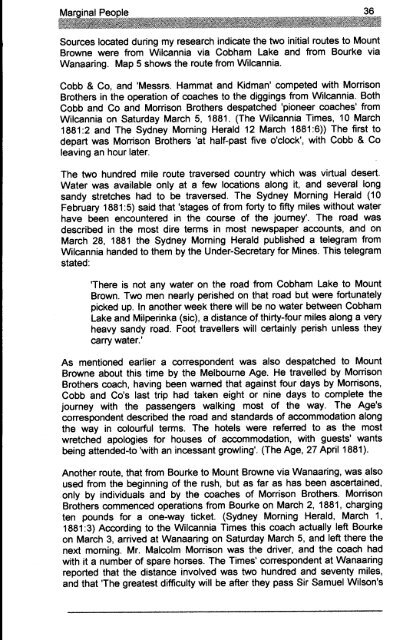Adec Preview Generated PDF File - The Sydney eScholarship ...
Adec Preview Generated PDF File - The Sydney eScholarship ...
Adec Preview Generated PDF File - The Sydney eScholarship ...
Create successful ePaper yourself
Turn your PDF publications into a flip-book with our unique Google optimized e-Paper software.
Sources located during my research indicate the two initial routes to Mount<br />
Browne were from Wilcannia via Cobham Lake and from Bourke via<br />
Wanaaring. Map 5 shows the route from Wilcannia.<br />
Cobb & Co, and 'Messrs. Hammat and Kidman' competed with Morrison<br />
Brothers in the operation of coaches to the diggings from Wilcannia. Both<br />
Cobb and Co and Morrison Brothers despatched 'pioneer coaches' from<br />
Wilcannia on Saturday March 5, 1881. (<strong>The</strong> Wilcannia Times, 10 March<br />
1881:2 and <strong>The</strong> <strong>Sydney</strong> Morning Herald 12 March 1881:6» <strong>The</strong> first to<br />
depart was Morrison Brothers 'at half-past five o'clock', with Cobb & Co<br />
leaving an hour later.<br />
<strong>The</strong> two hundred mile route traversed country which was virtual desert.<br />
Water was available only at a few locations along it, and several long<br />
sandy stretches had to be traversed. <strong>The</strong> <strong>Sydney</strong> Morning Herald (10<br />
February 1881:5) said that 'stages of from forty to fifty miles without water<br />
have been encountered in the course of the journey'. <strong>The</strong> road was<br />
described in the most dire terms in most newspaper accounts, and on<br />
March 28, 1881 the <strong>Sydney</strong> Morning Herald published a telegram from<br />
Wilcannia handed to them by the Under-Secretary for Mines. This telegram<br />
stated:<br />
'<strong>The</strong>re is not any water on the road from Cobham Lake to Mount<br />
Brown. Two men nearly perished on that road but were fortunately<br />
picked up. In another week there will be no water between Cobham<br />
Lake and Milperinka (sic), a distance of thirty-four miles along a very<br />
heavy sandy road. Foot travellers will certainly perish unless they<br />
carry water.'<br />
As mentioned earlier a correspondent was also despatched to Mount<br />
Browne about this time by the Melbourne Age. He travelled by Morrison<br />
Brothers coach, having been warned that against four days by Morrisons,<br />
Cobb and Co's last trip had taken eight or nine days to complete the<br />
journey with the passengers walking most of the way. <strong>The</strong> Age's<br />
correspondent described the road and standards of accommodation along<br />
the way in colourful terms. <strong>The</strong> hotels were referred to as the most<br />
wretched apologies for houses of accommodation, with guests' wants<br />
being attended-to 'with an incessant growling'. (<strong>The</strong> Age, 27 April 1881).<br />
Another route, that from Bourke to Mount Browne via Wanaaring, was also<br />
used from the beginning of the rush, but as far as has been ascertained,<br />
only by individuals and by the coaches of Morrison Brothers. Morrison<br />
Brothers commenced operations from Bourke on March 2, 1881, charging<br />
ten pounds for a one-way ticket. (<strong>Sydney</strong> Morning Herald, March 1,<br />
1881:3) According to the Wilcannia Times this coach actually left Bourke<br />
on March 3, arrived at Wanaaring on Saturday March 5, and left there the<br />
next morning. Mr. Malcolm Morrison was the driver, and the coach had<br />
with it a number of spare horses. <strong>The</strong> Times' correspondent at Wanaaring<br />
reported that the distance involved was two hundred and seventy miles,<br />
and that '<strong>The</strong> greatest difficulty will be after they pass Sir Samuel Wilson's




